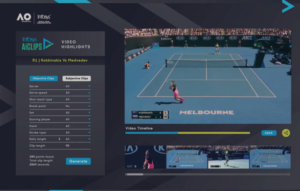Exclusives
M&E Journal: A Grand New Experience for the Grand Slam
Story Highlights
By Navin Rammohan, VP, Segment Head Marketing – Business Verticals, Sponsorships, Flagship Events, Infosys –
Artificial intelligence that produces match highlights in realtime. A real tennis merchandise store in the virtual world. A live data stream with point-by-point match analysis. With three game-changing platforms, the future of the tennis experience arrived at the Australian Open 2019.
January 14, 2019. A glorious summer sun paints the sky orange over Melbourne Park. Down below on the same canvas is a brighter, singular shade of blue — the hard court of the historic Rod Laver Arena. Between the sun and the surface is a sea of faces, dotting the picture with anticipation. The masterpiece awaits its master, and in steps the icon — Roger Federer. The anticipation turns to adulation as he squares off against Denis Istomin. The canvas is complete, and it is one of the most striking images in the world of sport — two superstar athletes ready to play for glory, as the setting sun gives way to the evening session of another Australian Open. It doesn’t get better than this. Or does it?
The quest and conquest of next
As glorious as the experience sounds, Infosys believed there was room for reinvention. As the digital innovation partner for the Australian Open, the global technology major brought to tennis the transformation chops of “navigating the next” for 1,222 enterprises in 45 countries. This time around, it had set its sights on shaping a digital sport for a digital age. For every fan in the arena, there were thousands outside at Melbourne Park who couldn’t be a part of that same experience. There were a billion more across the world who dreamed of being closer to the game from wherever they were. They were living in the age of experience, and fantasy that almost seemed closer to reality. If Shuri from Black Panther could drive a car for T’Challa in South Korea virtually from Wakanda, could a fan be away from the arena and yet be in it digitally?
 The game before the game
The game before the game
Infosys had no Avengers-like superheroes in its midst. But what it did have was a crew with a vision — technologists, marketers, design thinkers and experience shapers. And they were hard at work to bridge the gap between fantasy and reality for fans. They drew inspiration from futurist Arthur C. Clarke’s third law: Any sufficiently advanced technology is indistinguishable from magic. But they had added to Clarke’s list a law of their own: any technology must not just make the experience more state-of-the-art, it must also solve a real problem. And their game, much like tennis, would be played in three sets.
Set one: Bring on the data
Tennis is replete with scores and stats, but what was missing was understanding the ebbs and flows of a match as it unfolded. The Infosys team created Infosys MatchBeats, which enabled point-by-point analysis of every match with a live stream of data visualized in an interactive interface like a graphic equalizer for music beats. Fans and players could play match jockey on this digital console, to filter the stream and pinpoint turning points like aces, break points, winners, and unforced errors, in addition to seeing the number of shots played in each rally. This context also outlined the quality of the gameplay — filtering the winners would tell you whether a player like Serena Williams won the match with superior play. Conversely, applying the errors filter would tell you if her opponent had performed under-par.
Set two: AI sees an insight
Match highlights provide an insight into how the game was played and won, providing valuable trend-watching for fans and rich tape for players and coaches. But creating highlights is a highly manual task, and in a game like tennis, there are hundreds of turning points that merit deeper analysis. Infosys made this possible by assembling a machine with a mind for tennis: Ai Clips. This AI platform detected the most crucial points of the match using 120 filters and over 1,000 possible combinations. Finding all the winning backhands by slice or forehands by topspin was now just a tap away, as was finding the fastest serves. The best part: it was produced and served to broadcasters and social channels in near real-time.
 Set three: The experience that bridges worlds
Set three: The experience that bridges worlds
Most fans and players don’t have access to rich statistics-driven analytical coaching to improve their game. Infosys changed that with virtual reality training and gameplay simulated with real-world data sets. Thousands of fans make it to Melbourne Park but can’t grab a seat at the stadium. The VR experience brought the best seats in the house to them with 360º live VR broadcasts of every match, a first-of-its-kind experience for tennis. Another first was a real digital tennis store in the virtual world — fans could try merchandise on with digital avatars and actually check out their cart with virtual commerce transactions.
All of this was available in a single VR experience at Melbourne Park. The dream of immersion finally was a reality for fans — they were now one with the game.
Game, set, transformation
January 27, 2019. Once more, the setting sun descended on two masters of play like it had on Federer two weeks ago. But this wasn’t to be his centurion title effort. This evening belonged to Novak Djokovic and Rafael Nadal. And as they would serve up another experience of ecstasy and agony, this experience was already different. Fans who weren’t even on court would have the best seats in the house with VR—like 15,000 of them did over the tournament.
They would feel the pulse of each point with Match Beats—a stream that had been played over 16 million times in 15 days. And by the time Djokovic would hoist the trophy into the night, fans would have dissected every moment of greatness with Ai Clips. For them, the future of tennis had arrived with the next way to see, play, train and engage. To experience the next, now.
———–
Click here to translate this article
Click here to download the complete .PDF version of this article
Click here to download the entire Spring/Summer 2018 M&E Journal









